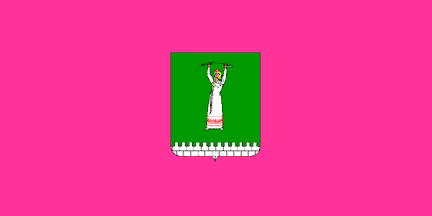 (1:2)
(1:2)image by Antonio Martins , 20 December 1999

Last modified: 2018-12-15 by rob raeside
Keywords: cherkasay | smila | girl | arrow | wall |
Links: FOTW homepage |
search |
disclaimer and copyright |
write us |
mirrors
 (1:2)
(1:2)
image by Antonio Martins , 20 December 1999
See also:
External sites:From the site of Ukrainian
Heraldry:
"On 10 July 1992, by the decision No. 8-21, the town council
approved the gonfalon: a rectangular crimson canvas with a ratio
of the sides: 1:2, in center of which there is a coat of arms of
the town in white framing."
Phil Nelson, 7 July 1999
I noticed very different
flag of the City of Smila, Cherkas'ka region, Ukraine. It is
shown at <smila.osp-ua.info>.
I'm not sure what is it, maybe some kind of official or
ceremonial flag?
On the other hand, the descrption fit to the image we have above.
Valentin Poposki, 12 September 2007
sml.jpg)
image from Smila city website
From the site of Ukrainian
Heraldry:
"On the 10th of July 1992 town council session (resolution
No. 8-21) confirmed a modern emblem. In a vert field there is a
girl in argent clothes with ornaments, with an or plate, a gules
headband. The girl is breaking a sable arrow into two over her
head. In the base of the shield there is an argent wall with
sable seams. The broken arrow symbolizes victory of the good over
the evil. The wall is a symbol of courage and fortitude."
Phil Nelson, 7 July 1999
From the site of Ukrainian
Heraldry:
"City in Cherkasy Oblast. The first mention refer to the
XVI century.In the 1648-1654 it was a squadron town if
Chygyrynsky regiment.In 1773 it was given the Magdeburg
Right.According to a legend during one of the numerous raids of
the Tartars a maiden led prince's army in the rear. The enemies
were defeated but the maiden was killed by the Tartars arrow.
Nobody knows her name. When a settlement appeared on the place of
the battle they named it Smela (from the word meaning
"brave")."
Phil Nelson, 7 July 1999
My ancient encyclopedia says, under the heading
"Magdeburg", "Magdeburg became a flourishing
commercial town during the 13th century, and was an important
member of the Hanseatic League..."Magdeburg law"
(Magdeburger Recht), securing the administrative independence of
municipalities, was widely adopted." Perhaps where the
source says "was given Magdeburg right" we should
translate "received the right of civic self-government"
or something similar.
John Ayer, 8 July 1999